Abstract
The effect of the coating process on the properties of reversible thermochromic waterborne coating on the surface of Chinese fir was examined. The results demonstrated that the most critical process parameter affecting the color difference and gloss of the coating was the way of adding thermochromic ink. The coating process had little influence on the adhesion, impact resistance adding, liquid resistance, and original properties of the coating. There was no obvious gloss variation in the coating under different coating processes. For the (3+3) layered coatings, when the thermochromic ink was added to the topcoats, the discoloration performance was the most obvious and the comprehensive performance of coating was better. Meanwhile, the gloss was 55.6%, the adhesion grade was grade 0, the impact resistance was 5.0 kg·cm, the liquid resistance grade of the coating to sodium chloride, ethanol and detergent was grade 1, and the liquid resistance grade to red ink was grade 3. The discoloration performance of the coating was stable under the conditions of aging and time change. This study provides new insight into preparing thermochromic intelligent waterborne wood coatings with potential practical applications on Chinese fir wood surfaces, and also lays a foundation for its application in furniture engineering.
1. Introduction
With the gradual improvement of people’s living standards, the market of relatively intelligent thermochromic wood furniture is growing [1]. The thermochromic coating is a kind of coating with a unique discoloration function [2]. When the temperature is higher than a certain value, the color of the coating changes [3]. When the temperature is lower than this value, the original color is restored [4]. The thermochromic coating can not only be used for surface temperature measurement [5], 3D printing [6], overtemperature warning [7], and anti-counterfeiting identification [8], but also for decoration [9]. At present, most of the thermochromic coatings are prepared by adding thermochromic materials into the coatings [10]. In addition, thermochromic materials can be generally divided into three categories: organic, inorganic, and liquid crystal thermochromic materials [11].
At present, in order to make thermochromic coatings widely used in various engineering fields, many researchers have carried out in-depth research. Veeramuthu et al. [12] fabricated new stretchable thermochromic transparent heaters using general commercial TM-55-blue and silver nanowire (AgNW)-coated polydimethylsiloxane. TM-55-blue promotes ultralow response time in smart window applications. Zhang et al. [13] prepared 12 kinds of thermochromic coatings by compounding the thermochromic powder with other additives. The color changing temperature was 31 °C, and the outdoor test proved the potential of thermochromic coatings in reducing building energy consumption. Wang et al. [14] prepared a poly-3,4-ethylene dioxythiophene coating, which provided a new idea for the preparation of a highly conductive coating with an obvious thermochromic effect on the textile pattern. Pan et al. [15] prepared the thermochromic vanadium dioxide films co-sputtered by vanadium and stainless-steel. It has good durability in high-temperature environments, whether humid or dry. The thermochromic coatings in these studies are chiefly used in the fields of windows, buildings, fabrics, infrared sensors, etc., while research on the thermochromic waterborne coatings applied to the surface of furniture and wood is relatively rare.
Organic reversible thermochromic materials are mainly composed of chromogenic agents and solvent, which have significant characteristics in the temperature of color change, color combination, and color contrast before and after color change [16]. Therefore, compared with inorganic and liquid crystal thermochromic materials, organic thermochromic materials are more popular because of their sensitive color change, rich color, good durability, long shelf life, and low cost. Organic reversible thermochromic ink has the advantages of convenient detection. They are fast, accurate, have no need for additional auxiliary equipment, and have a broad application prospect in thermochromic coatings [17]. Chinese fir is highly applied to construction, in bridges, house furnishings, woodwork, and other domains [18], on account of its light weight, good machinability, resistance to deforming, insect-resistance, anti-corrosion, and other excellent properties [19]. Waterborne wood coatings are free of volatile organic compounds (VOCs) [20] and air contaminants [21]. It has high safety, environmental protection, low cost, transparent color, and fast drying speed [22]. Therefore, it is widely used in woodworking, indoor decorative materials [23], building, automotive industry, carriers, and other fields, and has broad market application prospects [24].
Organic reversible thermochromic ink belongs to the gain and loss electron system [25]. At a certain temperature, it can change the composition and structure of the organic compounds and generate electron transfer, which is the key to changing the color [26]. The organic thermochromic ink is added to the waterborne coating and coated onto the wood surface, which can keep its original performance and obtain the ideal discoloration effect with changing temperature, making wood furniture more humanized and changeable. In this paper, to make the waterborne coatings have the best comprehensive performance, Chinese fir wood was selected as the substrate, and waterborne wood coatings as the coating. According to the layer number of the primer, the layer number of topcoat, and the way of adding thermochromic ink, the orthogonal experiment of three factors and two levels was carried out, and the factor that had a great influence on the experimental results was obtained by optimizing the process parameters. On this basis, the independent experiment was carried out to obtain the best experimental parameters. The novelty of this work in respect to previous work, was that the influence of the coating process on reversible waterborne thermochromic waterborne wood coating was explored, and the best coating process of coating was obtained by adding the best concentration of organic thermochromic ink, so as to lay the foundation for the development of thermochromic intelligent wood waterborne coatings.
2. Materials and Methods
2.1. Test Materials
The main components of thermochromic ink are methyl red (as leuco agent, MW: 269.30 g/mol, CAS No. 493-52-7), bisphenol A (as chromogenic reagent, MW: 228.29 g/mol, CAS No. 80-05-7), tetradecanol (as co-solvent, MW: 214.39 g/mol, CAS No. 112-72-1), and melamine (MW: 126.12 g/mol, CAS No. 108-78-1) which were provided by Huancai Discoloration Technology Co., Ltd., Shenzhen, China. The 37.0% formaldehyde solution (MW: 30.03 g/mol, CAS No. 50-00-0), triethanolamine (MW: 149.19 g/mol, CAS No. 102-71-6), sodium dodecyl benzene sulfonate (MW: 348.48 g/mol, CAS No. 25155-30-0), citric acid monohydrate (MW: 210.14 g/mol, CAS No. 5949-29-1), and anhydrous ethanol (MW: 46.07 g/mol, CAS No. 64-17-5) were supplied by Xilong Chemical Co., Ltd., Guangzhou, China. Waterborne acrylic coatings were supplied by Yihua Living Science and Technology Co., Ltd., Shantou, China. Waterborne acrylic coatings were composed of acrylic copolymers supported by water (the concentration was 90.0%), dipropylene glycolmethyl ether (the concentration was 2.0%), and dipropylene glycol butyl ether (the concentration was 8.0%). The solid concentration of the coating is about 26.5%. Chinese fir boards (100.0 mm × 100.0 mm × 12.0 mm, mechanically sanded, with uniform color) were supplied by Yihua Living Science and Technology Co., Ltd., Shantou, China. The Chinese fir boards have the radial sawn grain. All reagents in the experiment were used without further processing.
2.2. Preparation of Thermochromic Ink
Thermochromic microcapsules were prepared by in-situ polymerization. The experiment consists of three steps: preparation of wall prepolymer, preparation of core solution, and microencapsulation. A mixture of 15.0 g melamine and 30.0 g 37% formaldehyde solution was blended, and 30.0 mL deionized water was dropped into the mixture. The pH value of the mixture was adjusted to 8.2–8.7 by adding triethanolamine slowly. The mixture was set in a 70 °C water bath, the agitation speed was controlled at 700 rpm, and the agitation time was 1 h. After reaction, the wall prepolymer was cooled at room temperature. Then, 3.0 g sodium dodecyl benzene sulfonate was completely dissolved in 297.0 g deionized water, to obtain 1.0% emulsifier solution; and 3.0 g methyl red, 3.0 g bisphenol A, and 30.0 g tetradecanol were dropped into the emulsifier solution in turn and then reacted in a 60 °C water bath and 45 min agitation at 1200 rpm to compose core solution. Then the wall prepolymer was slowly dropped into core solution and mixed evenly. The pH value of solution was adjusted to 4.6–5.3 using citric acid monohydrate. The whole system reacted in a constant temperature water bath at 60 °C for 3 h, and then cooled to room temperature. After rinsing with deionized water and anhydrous ethanol many times and drying in a freeze dryer for 120 h, 19.0 g of microcapsules was obtained. The microcapsules were added into 36.0 g aqueous acrylic copolymer dispersion to obtain thermochromic ink.
2.3. Preparation of Thermochromic Waterborne Coatings
The pre-experiment result [27] showed that when the concentration of the thermochromic ink is 15.0%, the discoloration effect of coating on the surface of Chinese fir is better, and the mechanical properties are better. Thus, the concentration of thermochromic ink was fixed at 15.0%, and the influence of the coating process on coating performance was investigated thoroughly. In this experiment, layer numbers of the primer and topcoat were set as 2 and 3, in order to fill the wood pits and obtain a smooth surface of the coating. At the same time, the adding order of the thermochromic ink in different coating processes was changed, and the orthogonal test of three factors and two levels was carried out. Samples 1–4 were used for orthogonal test of coating process, as shown in Table 1. Table 2 showed the optimization test on this basis. Sample 5 was the optimization sample of the coating process with three-layer primer and three-layer topcoat as fixed factors, and thermochromic ink was added to primers. Sample 6 was the optimization sample of the coating process with three-layer primer and three-layer topcoat as the fixed factors, and the thermochromic ink was added to topcoats. Reversible thermochromic waterborne coating was prepared and then coated onto the Chinese fir board surface, according to the adding method of thermochromic ink in Table 1 and Table 2. The process of sample 1 was as follows: 50.0 g waterborne primer was coated on Chinese fir with SZQ (model) tetrahedral fabricator (Tianjin Jinghai Science and Technology Testing Machinery Factory, Tianjin, China) and dried naturally for 1 h. Then the sample was moved to 35 °C oven. The sample was taken out after heating to the mass no longer changed, and cooled naturally. The coating was sanded with 800 grit sandpaper, floating powder was cleaned out with a dry cloth, and the primer was coated again. The drying method was the same as above. Then, 7.5 g thermochromic ink and 42.5 g waterborne topcoat were mixed evenly, and the waterborne topcoat with 15.0% thermochromic ink was obtained. Then it was coated onto the surface of primer by SZQ tetrahedral fabricator. The coating was sanded after it dried, and was coated again and dried at room temperature for 1 h. The sample was shifted into a 35 °C oven for heating and drying. It was taken out after the mass no longer changed, and sample 1 was prepared after natural cooling. The preparation method of other samples (Figure 1) can refer to sample 1. The thickness of all the obtained (2+2), (2+3), and (3+3) layered coatings were about 60 μm.

Table 1.
Orthogonal experiment design of the coating process.

Table 2.
Optimization of the coating process of Chinese fir with waterborne coating.
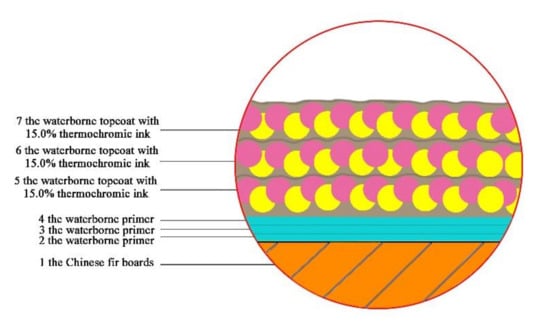
Figure 1.
A schematic of sample 4.
2.4. Performance Test
According to GB/T 3181-1995 [28], the color difference of coating was gauged by SEGT-J color difference meter (Gurun Photoelectric Technology Co., Ltd., Guangzhou, China). L, a, b, c, and H separately mean brightness and shade, red and green, yellow and blue values, the saturation of the color, and the hue of the coating. ΔL=L1-L2, Δa=a1-a2, Δb=b1-b2. L1, a1, and b1 mean the chromaticity value of coating at 18 °C. L2, a2, and b2 mean the chromaticity value of the coating at other temperatures. After subtraction, the difference of brightness, red-green, and yellow-blue can be obtained, which are ΔL, Δa, and Δb, respectively. Thus, the color difference, ΔE, can be calculated by Equation (1):
According to GB/T 9754-2007 [29], the gloss of coatings was gauged using the HG268 gloss meter (3NH Technology Co., Ltd., Shenzhen, China). According to GB/T 1732-1993 [30], the impact of coatings was gauged using the QCJ impactor (Jingkelian Material Testing Machine Co., Ltd., Tianjin, China). During the impact test, the coating was located on the anvil at the bottom of the apparatus. The hammer was lifted to a considerable altitude and dropped freely to impact the sample. The magnifying glass was observed, to judge if the coating had cracks, wrinkles, and peeling. If damage occurred, it was deemed to be unqualified at this height. If not, it was deemed to be qualified at this height. According to GB/T 1720-1989 [31], the adhesion of the coating was measured by the QFZ-II circle-cut coating adhesion tester (Benshan Instrument Equipment Co., Ltd., Shanghai, China). During the adhesion test, the tip of the rotating needle was contacted with a coating surface, the handle was shaken clockwise at a constant speed of 80–100 r/min, and the scratch length of the circular roller was 7.5 ± 0.5 cm. At the end of test, the coating damage was observed using a magnifier. The damage level of the coating can be divided into eight grades (grade 0, 1, 2, 3, 4, 5, 6, and 7). Grade 0 was the strongest, and grade 7 was the weakest. According to GB/T 1733-1993 [32], the liquid resistance of the coating was measured using 15.0% NaCl solution (Otopp Biotechnology Co., Ltd., Hangzhou, China), 70.0% medical ethanol (Otopp Biotechnology Co., Ltd., Hangzhou, China), detergent (Shanghai Hutchison Whitecat Co., Ltd., Shanghai, China), and red ink (Ningbo Sanshi Network Technology Development Co., Ltd., Ningbo, China). After soaking in the test solutions, the filter paper was taken out with a tweezer and placed on the test area of coating. Samples were covered by a glass cover. After 24 h, the glass cover and filter paper were removed. The residual liquid on the coating surface was absorbed, and the imprint and discoloration were checked. The microstructure of the thermochromic microcapsules and waterborne coatings corresponding to different coating processes, were analyzed using a Quanta 200 environment scanning electron microscope (SEM), FEI Company (Hillsboro, OR, USA). The dimension of the microcapsules was measured with a L2800 Biomicroscope (Guangzhou Liss Optical Instrument Co., Ltd., Guangzhou, China). The composition of the thermochromic microcapsules and waterborne coatings corresponding to different coating processes were analyzed using a Vertex 80V infrared spectrum analyzer (Germany Bruker Co., Ltd., Karlsruhe, Germany). The aging and stability test was measured in the ZN ultraviolet weather resistance tester (Nanjing Environmental Test Equipment Co., Ltd., Nanjing, China). All the experiments were repeated four times with an error of less than 5.0%.
3. Results and Discussion
3.1. Effect of Coating Process on the Coating Properties
The prepared microcapsules are shown in Figure 2. The particle size distribution is shown in Figure 3. The prepared microcapsules are spherical, with a particle size of about 3–5 µm and low crushing rate.
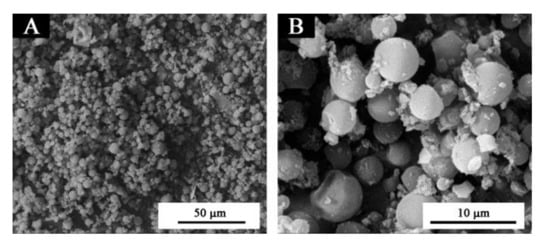
Figure 2.
SEM of thermochromic microcapsules: (A) low and (B) high magnification.
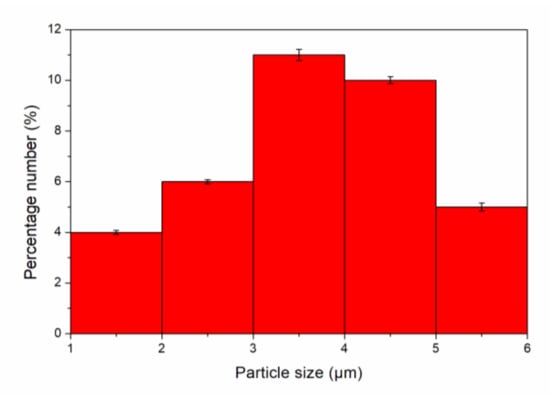
Figure 3.
Particle size distribution of microcapsules.
According to the indoor temperature in winter (about 18 °C), the highest indoor temperature in summer (about 40 °C), and the discoloration temperature of the coating (near 31 °C), 10 °C above and below 31 °C were selected as the discoloration value. The coatings obtained by different coating processes were heated from 18 °C to 40 °C, and the color change was recorded, as shown in Figure 4. The color difference of coatings from samples 1–3 at 18–30 °C was 0.3–5.7, with no obvious discoloration observed, and only the color difference value of the coating of sample 4 reached 12.9. The coatings of samples 1–4 had significant discoloration at 32 °C, and the color difference was 13.1–21.4. Table 3 and Table 4 are the orthogonal test results of the influence of the coating process on the color difference of coating. The greater the range, the more significant the change of this factor on the color difference. The order of influence on color difference was: way of adding thermochromic ink, layer number of topcoat, and layer number of primer. The color difference of the coating was greater and the discoloration effect became better when there were three layers of primer and three layers of topcoat.
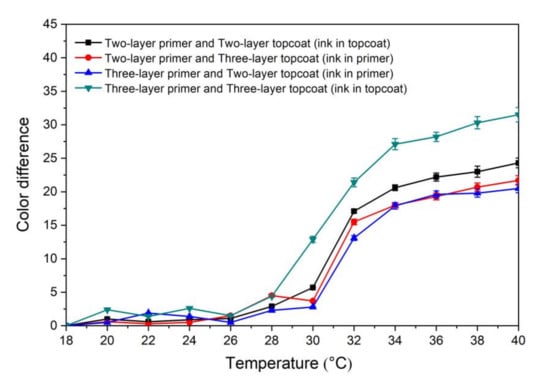
Figure 4.
The color difference change of waterborne coating on Chinese fir from 18 to 40 °C.

Table 3.
Orthogonal experimental result of the influence of coating processes on the color difference of coating.

Table 4.
Range of the color difference of coating.
Table 5 showed the influence of coating processes on the gloss of the coating at different incident angles (20°, 60° and 85°). With the incident angle of light increasing, the gloss of the coating with the same coating process increased, because the reflected light intensity on the coating surface increased with the incident angle of light increasing, which led to the increase of the gloss of coating. According to GB/T 9754-2007, 60° geometric conditions are applicable to all coatings, so 60° gloss was selected for discussion in this paper. From Table 6 and Table 7, the most influential coating process on the 60° gloss of coating, was the way of adding thermochromic ink, followed by layer number of primer, and layer number of topcoat. With two layers of primer and three layers of topcoat, the coating gloss was higher. The coating gloss with the thermochromic ink added in primer was higher than that in topcoat, because the thermochromic ink in primer did not affect the original gloss of the topcoat. The thermochromic ink was directly added to the topcoat, increasing particles in topcoat, and the surface become rough so that the gloss was reduced.

Table 5.
The gloss change of waterborne coating on Chinese fir.

Table 6.
Orthogonal experimental result of the influence of the coating process on the 60° gloss of coating.

Table 7.
Range of the gloss of coating.
From Table 8, the adhesion grades of the coating on samples 1–4 were grade 0, and the adhesion of the coatings was good. It showed that the coating processes had no effect on the adhesion of the coatings. The coatings had good adhesion under different coating processes, which was due to the adhesion of the waterborne coating itself. As can be seen from Figure 5, the impact resistance of coatings on samples 1–4 were 5.0 kg·cm, indicating that the coating processes did not affect the impact resistance of the coatings. The liquid resistance tests were carried out on the coating with different coating processes. The temperature was fixed at 18 °C, and L, a, b, c, and H color values of coatings were gauged and recorded before and after the 24 h tests. According to Equation (1), the color difference was calculated. The liquid resistance grades were analyzed in Figure 6. After NaCl, detergent, and ethanol tests, the coatings of samples 1–4 were basically free of marks, and the liquid resistance grades were grade 1. After the red ink test, the coatings of sample 1–4 had obvious marks, and the liquid resistance grades were grade 3. It proved that the coating processes did not affect the film’s liquid resistance.

Table 8.
Orthogonal experimental result of the influence of the coating process on the adhesion of coating.

Figure 5.
The impact resistance of waterborne coating on Chinese fir (samples 1–4 from Table 1).
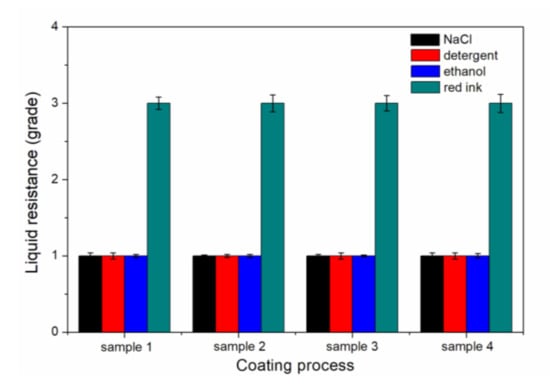
Figure 6.
The liquid resistance of waterborne coating on Chinese fir (samples 1–4 from Table 1).
The orthogonal tests showed that the way of adding thermochromic ink was the most important factor affecting the overall performance of the coating. The discoloration effect is more critical than gloss in the thermochromic waterborne coatings. Therefore, three layers of primer and three layers of topcoat were determined as the fixed factors for the following study.
3.2. Coating Process Optimization
The fixed primer was three layers, and the topcoat was three layers. The way of adding thermochromic ink was changed, which were thermochromic ink in primer and thermochromic ink in the topcoat. The optimization tests of the coating process were carried out. In Figure 6, the color difference of coatings for sample 5 and sample 6 was 1.0–4.4 at 18–28 °C, without obvious discoloration. When the coating of sample 6 was heated to 30 °C, the color difference was 12.9, and the color had a significant change. The color difference values of the coating of sample 6 at 30–40 °C were more significant than that of the coating of sample 5. The temperature of sample 6 was lower than that of sample 5 when discoloration occurred, and the discoloration effect was more obvious. Therefore, it was preliminarily considered that the coating of sample 6 had better discoloration effect.
The coatings of samples 5 and 6 were heated to 40 °C in the oven, and taken out and cooled to 18 °C naturally. The color values of 40–18 °C were measured, and the color difference was calculated. Figure 7 showed the change of color difference of coating on Chinese fir surface with different coating process. The changing trend from Figure 7 and Figure 8 showed that the coatings discoloration was reversible. In Figure 7, sample 6 took off around 26 °C during warming-up, and in Figure 8, sample 6 dropped down around 32 °C during cooling, which may be due to electron transfer caused by temperature change [33].
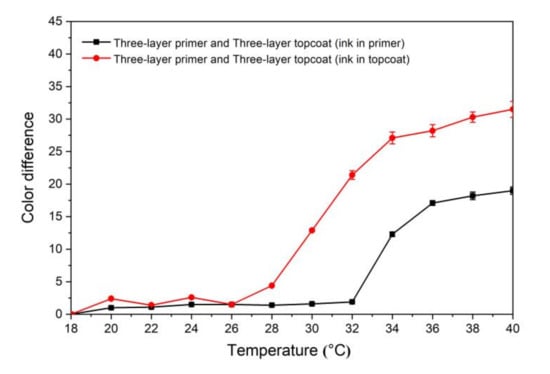
Figure 7.
Change of color difference of waterborne coating on Chinese fir surface at warming-up.
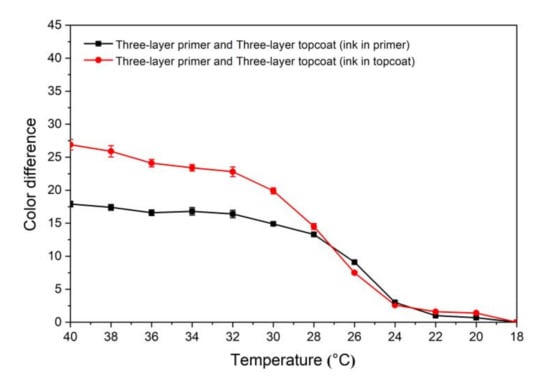
Figure 8.
Change of color difference of waterborne coating on Chinese fir surface at cooling.
Table 9 showed that under the same coating process, the coating gloss increased with the increase of incident angle. The analysis of 60° gloss showed that the coating on sample 5 and sample 6 both had higher gloss under 60° gloss. This showed that after further optimization of the processes by orthogonal tests, the effect of adding thermochromic ink to the primer and the topcoat on the gloss fluctuated little. Both of them can obtain a high gloss. From Table 10, the coatings on sample 5 and sample 6 have good adhesion, which was grade 0. In Figure 9, the impact resistances were 5.0 kg·cm, which showed that the coating processes had no effect on the adhesion and impact resistance of the coatings. As can be seen from Figure 10, the coatings of sample 5 and sample 6 were tested by NaCl, medical alcohol, and detergent, and the surface of the coatings had no marks and the liquid resistance grade was grade 1. After the red ink test, there were obvious marks on the surface of the coating, and the liquid resistance grade was grade 3. The results showed that the coating process did not affect the liquid resistance of the coatings.

Table 9.
The gloss change of waterborne coating on Chinese fir.

Table 10.
Orthogonal experimental result of the influence of the coating process on the adhesion of coating.
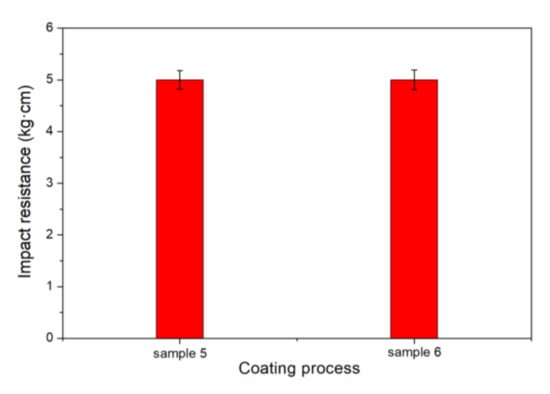
Figure 9.
The impact resistance of waterborne coating on Chinese fir (samples 5–6 from Table 2).
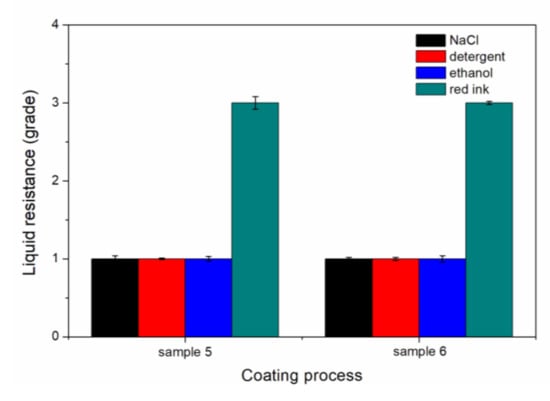
Figure 10.
The liquid resistance of waterborne coating on Chinese fir (samples 5–6 from Table 2).
In Figure 11, the ink surface was uneven and had more particles after drying, and the waterborne primer and topcoat were relatively smooth, with fewer particles. There was no agglomeration under the microcosmic conditions of the two coating processes. As marked in the red boxes, the particles in the coating added by thermochromic ink in the topcoat are more obvious than those in the primer. The microstructure of the coating (sample 6) added by thermochromic ink in topcoat was better, because thermochromic ink had the fluidity of liquid, and the coating added in topcoat had more particles on the Chinese fir board surface.
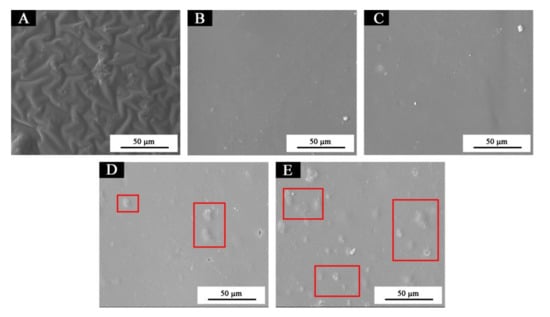
Figure 11.
SEM of the waterborne coating with different coating processes: (A) thermochromic ink, (B) pure primer, (C) pure topcoat, (D) three-layer primer, three-layer topcoat and thermochromic ink in primer, (E) three-layer primer, three-layer topcoat and thermochromic ink in topcoat. (The thickness of the coatings with A–E was about 60 μm).
From Figure 12, 3431 cm−1 and 3315 cm−1 are the absorption peaks of –OH. 2930 cm−1; 2850 cm−1 and 1446 cm−1 are the absorption peaks of -CH2. 1730 cm−1 is the strong characteristic peak with C=O. In the infrared spectrum test, no peak disappeared or appeared under different coating conditions. The results showed that there was no difference in the composition of the coating, the function of the thermochromic ink was not affected, and it still had a good discoloration effect. The discoloration mechanism is as follows: with the change of temperature, electron transfer occurs in the system. Methyl red is used as an electron donor and bisphenol A is used as an electron acceptor, which makes the coating change from red to colorless when the temperature increases, and from colorless to the original color when the temperature decreases [33].
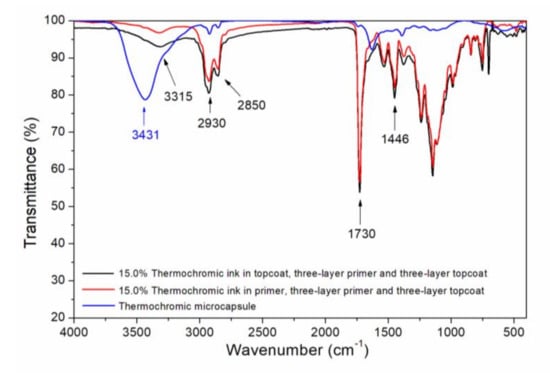
Figure 12.
Infrared spectra of the waterborne coating with different coating process and thermochromic microcapsules.
3.3. Effect of Time on the Discoloration of Coatings
According to the above results, the general performance of the coatings is better when the primer is three-layered, topcoat is three-layered, and thermochromic ink is added to the topcoat. The discoloration performance of the coatings coated by this optimized process, and with thermochromic ink added, were tested. The color values of the paint film after three months at room temperature, and the color values after baking in a 30 °C oven for the next 3 days were measured. It can be seen from Table 11 that after aging tests, the color values of the coatings basically had no obvious change, indicating that the coatings had not been significantly damaged. After three months, the color differences of coatings were 1.5–1.8 at 18 °C and at 30 °C for three consecutive days (Table 12), without obvious discoloration. The results showed that time has no effect on the discoloration of the coatings on Chinese fir surface.

Table 11.
Effect of time on color value of discoloration coating.

Table 12.
Effect of time on the color difference of discoloration coating.
The ultraviolet weather resistance test of the waterborne wood coating with three-layer primer, three-layer topcoat, and thermochromic ink added to the topcoat, were carried out for three months. The results of color value and gloss of waterborne wood coatings are shown in Table 13. The waterborne wood coating before and after aging resistance was analyzed using a SEM (Figure 13). The results showed that the color difference of waterborne wood coatings after ultraviolet-accelerated aging was 8.7, and gloss was slightly reduced (Table 13). No cracking was found by SEM, which indicated that the waterborne wood coatings had good stability and aging resistance in the ultraviolet weather resistance test.

Table 13.
Color value and gloss of waterborne wood coating before and after aging.

Figure 13.
SEM of waterborne wood coatings with three-layer primer, three-layer topcoat, and thermochromic ink added to the topcoat: (A) before and (B) after aging.
4. Conclusions
In this paper, the thermochromic microcapsules were mixed with waterborne coatings to prepare thermochromic waterborne coatings that were coated to the surface of Chinese fir. The effects of different coating processes on the performance of the waterborne coatings, with the best concentration of 15.0% thermochromic ink, were studied. Among the three factors of coating process, the way of adding thermochromic ink had the greatest influence on the color difference of the coating. The color difference of the coating was greater and the discoloration effect was better when the primers were three layered and the topcoats were three layered. The temperature of the thermochromic ink added in the topcoat was lower than that in the primer, and the discoloration effect was more obvious. The comprehensive properties of the coating of reversible thermochromic waterborne coating on the surface of the Chinese fir board were better by using the coating process of three-layer primer, three-layer topcoat, and thermochromic ink in topcoat. Under such conditions, the discoloration effect of the coating was noticeable. Compared with other coating processes, the discoloration performance of the coating was not affected by time. Compared with previous work [27], the gloss of the coating was 7.2% higher, the impact resistance was 1.0 kg·cm greater, the adhesion level and the liquid resistance of the coating to sodium chloride, ethanol, detergent, and red ink was the same, time had no effect on the thermochromism of the coating, and the thermochromic performance of the coating was stable. This work provides an effective approach for intelligent coatings on Chinese fir wood surfaces.
Author Contributions
Conceptualization, Methodology, Validation, Resources, Data Curation, Writing—Original Draft Preparation, Supervision, X.Y.; Data Analysis, L.W. and X.Q.; Investigation, Writing—Review And Editing, L.W. All authors have read and agreed to the published version of the manuscript.
Funding
This research was funded by the Youth Science and Technology Innovation Fund of Nanjing Forestry University (CX2016018).
Acknowledgments
The authors are grateful for financial support from the Youth Science and Technology Innovation Fund of Nanjing Forestry University (CX2016018).
Conflicts of Interest
The authors declare no conflict of interest.
References
- Hu, L.; Lyu, S.Y.; Fu, F.; Huang, J.D.; Wang, S.Q. Preparation and properties of multifunctional thermochromic energy-storage wood materials. J. Mater. Sci. 2016, 51, 2716–2726. [Google Scholar] [CrossRef]
- Schlaefer, J.; Sol, C.; Li, T.; Malarde, D.; Portnoi, M.; Macdonald, T.J.; Laney, S.K.; Powell, M.J.; Top, I.; Parkin, I.P.; et al. Thermochromic VO2-SiO2 nanocomposite smart window coatings with narrow phase transition hysteresis and transition gradient width. Sol. Energy Mater. Sol. Cells 2019, 200, 109944. [Google Scholar] [CrossRef]
- Zomaya, D.; Xu, W.Z.; Grohe, B.; Mittler, S.; Charpentier, P.A. W-doped VO2/PVP coatings with enhanced thermochromic performance. Sol. Energy Mater. Sol. Cells 2019, 200, 109900. [Google Scholar] [CrossRef]
- Pedaballi, S.; Li, C.C.; Song, Y.J. Dispersion of microcapsules for the improved thermochromic performance of smart coatings. RSC Adv. 2019, 9, 24175–24183. [Google Scholar] [CrossRef]
- Jonsson, J.C.; Goudey, H.; Curcija, C. An edge-heating device for optical measurement of thermochromic glazing materials and recommended test procedure. J. Test. Eval. 2014, 42, 305–311. [Google Scholar] [CrossRef]
- Du, J.H.; Chen, Q.N.; Xu, Y.; Li, W.; Wang, X.J.; Li, M.J.; Zhang, S.X.A. Simple and general platform for highly adjustable thermochromic fluorescent materials and multi-feasible applications. Mater. Horiz. 2019, 6, 1654–1662. [Google Scholar] [CrossRef]
- He, Y.Y.; Li, W.; Han, N.; Wang, J.P.; Zhang, X.X. Facile flexible reversible thermochromic membranes based on micro/nanoencapsulated phase change materials for wearable temperature sensor. Appl. Energy 2019, 247, 615–629. [Google Scholar] [CrossRef]
- Patel, R.G.; Patel, M.P.; Patel, R.G. 3,6-Disubtituted fluorans containing 4(3H)-quinazolinon-3-yl, diethyl amino groups and their application in reversible thermochromic materials. Dyes Pigments 2005, 66, 7–13. [Google Scholar] [CrossRef]
- Yang, H.Y.; Wang, Y.Z.; Yu, Q.Q.; Cao, G.L.; Yang, R.; Ke, J.N.; Di, X.; Liu, F.; Zhang, W.B.; Wang, C.Y. Composite phase change materials with good reversible thermochromic ability in delignified wood substrate for thermal energy storage. Appl. Energy 2018, 212, 455–464. [Google Scholar] [CrossRef]
- Mehta, L.; Wadgaonkar, K.; Suryawanshi, M.; Jagtap, R. Solvent-free microwave-assisted synthesis and characterization of polybenzoxazine as a thermochromic material for smart coatings. Colloid Polym. Sci. 2019, 297, 795–798. [Google Scholar] [CrossRef]
- Liang, R.Q.; Sun, Y.Y.; Aburas, M.; Wilson, R.; Wu, Y.P. An exploration of the combined effects of NIR and VIS spectrally selective thermochromic materials on building performance. Energy Build. 2019, 201, 149–162. [Google Scholar] [CrossRef]
- Veeramuthu, L.; Chen, B.Y.; Tsai, C.Y.; Liang, F.C.; Venkatesan, M.; Jiang, D.H.; Chen, C.W.; Cai, X.K.; Kuo, C.C. Novel stretchable thermochromic transparent heaters designed for smart window defroster applications by spray coating silver nanowire. Rsc Adv. 2019, 9, 35786–35796. [Google Scholar] [CrossRef]
- Zhang, Y.X.; Zhai, X.Q. Preparation and testing of thermochromic coatings for buildings. Sol. Energy 2019, 191, 540–548. [Google Scholar] [CrossRef]
- Wang, H.; Yue, L.N.; Wang, X.W.; Deng, M.G.; Sun, Y.J.; Gao, M. Imitation-mussel-based high-performance conductive coating on hydrophobic fabric for thermochromic application. J. Appl. Polym. Sci. 2019, 136, 47751. [Google Scholar] [CrossRef]
- Pan, G.T.; Yang, Y.L.; Chong, S.H.; Arjun, N.; Yang, T.C.K.; Lai, Y.C. The durability study of thermochromic vanadium dioxide films with the addition of barrier coatings. Vacuum 2017, 145, 158–168. [Google Scholar] [CrossRef]
- Zhang, G.X.; Chan, J.M.W. Reversibly thermochromic bismuth-organic materials with tunable optical gaps. J. Mater. Chem. C 2017, 5, 10007–10015. [Google Scholar] [CrossRef]
- Hanzer, S.J.; Rozic, M.; Vukoje, M.; Jukic, M.; Galic, A. safety evaluation of deinked pulp containing offset thermochromic inks. Bioresources 2018, 13, 678–690. [Google Scholar]
- Xu, W.; Fang, X.Y.; Han, J.T.; Wu, Z.H.; Zhang, J.L. Effect of coating thickness on sound absorption property of four wood species commonly used for piano soundboards. Wood Fiber Sci. 2020, 52, 28–43. [Google Scholar] [CrossRef]
- Li, Z.; Jiang, J.L.; Lu, J.X. Moisture-dependent orthotropic viscoelastic properties of Chinese fir wood during quenching in the temperature range of 20 to −120 °C. Holzforschung 2020, 74, 10–19. [Google Scholar] [CrossRef]
- Sun, S.J.; Zhao, Z.Y.; Shen, J. Effects of the manufacturing conditions on the VOCs emissions of particleboard. Bioresources 2020, 15, 1074–1084. [Google Scholar]
- Xiong, X.Q.; Fang, L.; Wu, Z.H.; Zhang, M.; Lu, R.; Tetsuo, M. Special coating technology and film performance of rice straw particleboard. J. Wood Fiber Sci. 2016, 72, 139–146. [Google Scholar]
- Liu, Y.; Hu, J.; Wu, Z.H. Fabrication of coatings with structural color on a wood surface. Coatings 2020, 10, 32. [Google Scholar] [CrossRef]
- Sun, S.J.; Zhang, M.; Umemura, K.; Zhao, Z.Y. Investigation and characterization of synthesis conditions on sucrose-ammonium dihydrogen phosphate (SADP) adhesive: Bond performance and chemical transformation. Materials 2019, 12, 4078. [Google Scholar] [CrossRef] [PubMed]
- Xiong, X.Q.; Bao, Y.L.; Guo, W.J.; Fang, L.; Wu, Z.H. Preparation and application of high performance corn starch glue in straw decorative panel. Wood Fiber Sci. 2018, 50, 88–95. [Google Scholar]
- De Bastiani, M.; Saidaminov, M.I.; Dursun, I.; Sinatra, L.; Peng, W.; Buttner, U.; Mohammed, O.F.; Bakr, O.M. Thermochromic perovskite inks for reversible smart window applications. Chem. Mater. 2017, 29, 3367–3370. [Google Scholar] [CrossRef]
- Kulcar, R.; Friskovec, M.; Hauptman, N.; Vesel, A.; Gunde, M.K. Colorimetric properties of reversible thermochromic printing inks. Dyes Pigments 2010, 86, 271–277. [Google Scholar] [CrossRef]
- Yan, X.X.; Chang, Y.J.; Qian, X.Y. Effect of the concentration of pigment slurry on the film performances of waterborne wood coatings. Coatings 2019, 9, 635. [Google Scholar] [CrossRef]
- GB/T 3181-1995 Colour Standard for Paint Film; Standardization Administration of the People’s Republic of China: Beijing, China, 1995; pp. 10–17. (In Chinese)
- GB/T 9754-2007 Paints and Varnishes—Determination of Specular Gloss of Non-Metallic Paint Films at 20°, 60° and 85°; Standardization Administration of the People’s Republic of China: Beijing, China, 2007; pp. 1–9. (In Chinese)
- GB/T 1732-93 Determination of Impact Resistance of Film; Standardization Administration of the People’s Republic of China: Beijing, China, 1993; pp. 418–420. (In Chinese)
- GB/T 1720-89 Determination of Adhesion of Film; Standardization Administration of the People’s Republic of China: Beijing, China, 1979; pp. 378–379. (In Chinese)
- GB/T 1733-93 Determination of Resistance to Water of Films; Standardization Administration of the People’s Republic of China: Beijing, China, 1993; pp. 421–423. (In Chinese)
- Yan, X.X.; Chang, Y.J. Investigation of waterborne thermochromic topcoat film with colorchanging microcapsules on Chinese fir surface. Prog. Org. Coat. 2019, 136, 105262. [Google Scholar] [CrossRef]
© 2020 by the authors. Licensee MDPI, Basel, Switzerland. This article is an open access article distributed under the terms and conditions of the Creative Commons Attribution (CC BY) license (http://creativecommons.org/licenses/by/4.0/).